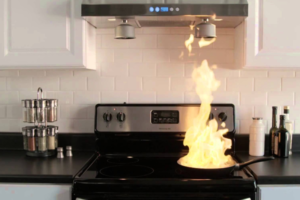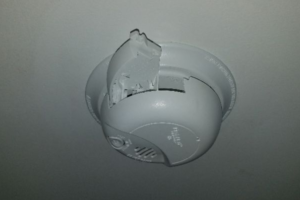Every year the National Fire Protection Association (NFPA) designates a fire prevention week, and this week is it! The theme this year is Cooking Safety Starts with YOU, and we are here to help spread awareness to prevent house fires.
Cooking is Fun – Except When It Starts a Fire
Two of every five home fires start in the kitchen. The sad fact is that most kitchen fires are avoidable. About 1/3 of home cooking fires are caused by inattentive cooks or unattended cook-tops or ovens. The other 2/3 of fires are started because of ignition of food (yes, food catches on fire) or other cooking materials (oils and fats).
Here’s our short list for preventing cooking fires:
- Stay put while cooking – Keep a close eye on the stove when cooking and do not leave unattended
- Clear the cook-top – Keep your stove-top and oven clear of storage and anything that can catch fire – such as oven mitts, towels, food storage, and wooden utensils

It can happen in the blink of an eye. - Keep the kiddos safe – Children under five face a higher risk of burns associated with hot food and drinks than being burned in a cooking fire
- Monitor the microwave – Microwaves are one of the leading appliances which cause scald burn injuries
Cook with Caution
Not surprisingly, most cooking fires involve the kitchen stove. If you are cooking and a small grease fire begins, there are a few steps you can take to contain the fire and stop it in its tracks:
- If a fire breaks out on the stovetop, slide a lid over the pan to smother the flame and turn off the burner. Leave the pan covered until it is completely cooled.
- If a fire breaks out in the oven, turn the oven off and keep the door closed.
When in doubt, get out! If you have any hesitations or doubts about putting out a small fire yourself, get out and call 911. Make sure to close all doors behind you to contain the fire.
Though this year’s theme is cooking safety, it is important to be aware of and prevent house fires in other areas of the home as well.
Heating Equipment – Maintain for No Pain
The leading factor contributing to heating equipment fires also is avoidable – failure to clean creosote and other build-up from solid fuel heating equipment (chimneys). Another major factor in house fires is combustibles which ignite because they’re too close to the heater; 1/2 of home heating fire deaths resulted from fires caused by heating equipment too close to things that can burn.
Here’s our short list for preventing heating equipment fires:
- Chim, chimney, cheree – Hire a chimney sweep to clean your chimney
- Distance combustibles – Keep combustibles (upholstered furniture, clothing, mattresses, bedding) away from heat sources
- Avoid space heaters – Fixed or portable space heaters are involved in about 4 out of 5 heating fire deaths

Curtains too close to the baseboard heater. - Cord review – Check all cords for frays or cracks, which can spark and cause fires
- Service the electrics – All electrical components in your home should be serviced and monitored; about half of home electrical fires involved electrical distribution or lighting equipment
- Service the appliances – Other suspects for starting fires include washer, dryer, air conditioning equipment, water heater and range; get an annual service contract to have the equipment checked by a professional.
Bed is for Sleeping, Not Smoking
Most fires caused by cigarettes are related to a person falling asleep while smoking. Sleep-related smoking fires are a factor in almost 1/3 of home smoking material fire deaths. Don’t smoke in bed.
Ever Ready – Smoke Alarms and Escape Plans

Our inspectors report inoperable smoke alarms in dozens of homes every day, even though working smoke alarms reduce the risk of dying in home fires by 1/2. Regrettably, almost 60% of reported home fire deaths result from fires in homes with no smoke alarms or no working smoke alarms.
Even with working smoke alarms, accidents happen. Unfortunately, only 1/3 of households have developed and practiced a home fire escape plan, according to the NFPA. Develop and practice an escape plan.
Recipe For Safety
There are many areas regarding fire safety that require vigilance, including home inspection issues which we report consistently. The good news is that proper prevention and consistently applied home safety techniques can significantly reduce the probability of home fires!
